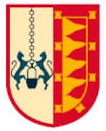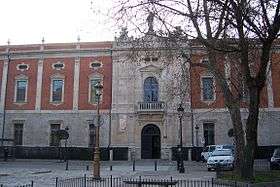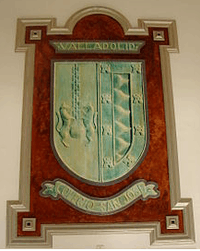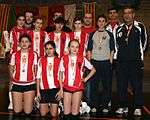San Jose College, Valladolid
| San Jose College, Valladolid | |
|---|---|
 | |
| Location | |
| Valladolid, Castile and León, Spain | |
| Information | |
| Type | Jesuit, Catholic |
| Established | 1881 |
| Director | Carlos Entrambasaguas |
| Staff | 84 teachers |
| Gender | Coeducational |
| Enrollment | 1,248 |
| Website | SanJoseVal |
 | |
San Jose College, Valladolid, is a Catholic school run by the Society of Jesus, in Valladolid (Castile and León, Spain). It teaches in the following cycles of the educational system of Spain: pre-primary, primary, high school (ESO), and baccalaurate. The building, designed by Ortiz de Urbina, is considered a good example of the eclecticism of the time.[1]
History
In 1881 the Society of Jesus received an important donation from Justa López Martínez, thanks to which it was possible to found Colegio de San José in the former and disappeared Plazuela del Duque No. 7, next to the Church of San Juan. A year later in 1882, the Jesuits obtained the land of the old monastery of Bethlehem run by the Bardardas nuns, that was in front of Santa Cruz School. On February 17 of that year the promoter Fr. Gregorio Remón asked the City Council for permission to expand into the public Plazuela de Belén in order to expand the campus of the school.[2] With this granted work began, with the foundation stone laid on June 8, 1882, the feast of Corpus Christi. The building was completed in 1884 and occupied on January 30, 1885.
In 1931 the Congress of Deputies of Spain decreed the dissolution of the Society of Jesus and on January 24, 1932, their property was seized. In order not to interrupt the teaching, classes were distributed among some flats and chalets inside Valladolid. In 1936 the classrooms of the College were opened again, sharing with the military that had occupied some dependencies. Two years later, the Society of Jesus was reestablished throughout Spain.
The school opened with classrooms well furnished and with special laboratories for physics, chemistry, and natural science. There was a drawing room (with plaster models and copies of engravings), a music room with several pianos, and an auditorium. A chapel was also built.
Awards and celebrations
In 1956 the City Council of Valladolid awarded the school the gold medal of the city. In 2006 the 125th anniversary of the College was celebrated. In 2007 the College obtained the European Excellence Stamp 400+ according to the EFQM Excellence Model.
Description of the building
At the main entrance that opens in a half-point arch there is a very large balcony, with pediment and stone balustrade that in turn is flanked by ribbed pilasters. The architect of the building was Jerónimo Ortiz de Urbina, professor at the School of Fine Arts and academician of the Real Academia de Bellas Artes de la Purísima Concepción, Iglesia de la Inmaculada Concepción (Valladolid), assisted by his son Antonio Ortiz de Urbina and Olasagasti, master of arts.
He envisaged it in an eclectic style. The building came to occupy two blocks, one of which was sold in the last third of the twentieth century giving way to a series of houses. The rectangular building is built around two courtyards. Its main facade (the one that opens to the square of the Colegio de Santa Cruz) is divided into two parts, though the height of the building is the same all around. Brick and stone were used as building materials.
On the main door that opens in a half-point arch there is a very large balcony, with pediment and stone balustrade that in turn is flanked by ribbed pilasters. Upstairs in the attic can be seen a stone statue of Saint Joseph, three meters high, manufactured by Franz Mayer of Munich. On both sides and in some small recessions you can see the shields that symbolize the arts and sciences with their attributes. The windows are separated by pilasters. They have pediments and an oval window framed with stone. The entrance is spacious and leads to a patio with garden. The patio is surrounded by four galleries as if it were a cloister on whose walls, in addition to the ornamentation of pictures, are photographs of students and of different events, augmented yearly.
The Chapel
The chapel was inaugurated the 8th of December in 1885. It has a wealth of ornamentation. The Spanish painter and sculptor Luis Muriel López painted the ceiling with the theme of the apotheosis of Saint Joseph. The side walls were decorated with oil paintings, with passages concerning the Holy Family. The polychrome, stained-glass windows present the theme of the life of St. Joseph in Japanese style.[3] A wooden carving of the Purisima is presided over by the high altar and a Child Jesus by the Catalan sculptor Francesc Font. The stained-glass windows, the altarpiece, and the image of the Virgin come from the Mayer house in Munich.
|
School festivities
March 19th, the feast of Saint Joseph, festivities are held for the patron saint of the school.
Publications
The Catalogue is the school annual, containing pictures of the school council, administration, and teachers, as well as the classes and an alphabetical listing of the students.
College chorus and orchestra
The College has long been dedicated to school music. Every year there are at least four, two-day festivals: Saint Cecilia, Christmas Festival, school feasts, and a zarzuela at the end of the year, all under the direction of Luis Cantalapiedra. He began his work as director of the college choir and orchestra in 1975 and on the 40th anniversary in 2015 held a Spring Recapitulation Festival. This included intramural and extramural performances of the choir and orchestra for various organizations. The orchestra has violins, violas, cellos, basses, flutes, clarinets, saxophones, trumpets, horns, keyboards, bass, drums, and guitars. From the school came musicians who later were in Celtas Cortos, as well as conductor of the University of Valladolid orchestra Francisco Lara Tejero, Bratislava Orchestra David Hernando Rico, baritone Eduardo del Campo, trompeter in the orchestra of the Liceo Theater of Barcelona Ignacio Zamora Rodríguez, director of the Mario Garrote Conservatory Eduardo del Campo, and many other noted Spanish musicians. The College Choir and Orchestra website contains the recordings of festivals and zarzuelas since 1984.[4]
Sports
San José College has numerous titles in football, basketball, and volleyball and has participated several times in the National Championships. Traditional local rivals are Our Lady of Lourdes, La Salle, and La Inmaculada (Marists).
Sports facilities in the outer courtyards, next to the main building. Members of the women's volleyball team. Patio for sport. Sports facilities in the outer courtyards, next to the main building.
Symbols

The school shield is divided into two parts, a caldron hanging from a chain supported by two wolves, and the flames representing the shield of Valladolid. The light blue school flag has the shield in the center. The colors of the school are red (Pantone 485) and white.
The sports uniforms for federated competitions have red and white stripes with the school shield at the right or center; the pants or shorts are black. The general sports uniform is blue trousers with a red stripe, and a red long-sleeve polo shirt with the letters of the school vertical on the left side and school crest on the right.
The student uniform is compulsory except in high school. Boys wear dark gray trousers and white polo with a blue and red stripe and the shield of the College. The blue navy sweater has the school crest and two red stripes, on the cuffs and at the waist. Girls wear a skirt of blue and red squares, with blue socks.
Alumni association
Founded in 1915 by a group of alumni, its main purpose is not to lose contact with former classmates or with the College. During the year the association convenes three times: on the feast of the Immaculate Conception, on the feast of St. Joseph, and for a general meeting. At the annual meeting a "Distinguished Old Student" is appointed who seems deserving by virtue of his merits and/or his personal and professional involvement. The association encourages alumni meetings and promotes 25 and 50 year reunions.
The association has launched a Five-a-side football league among the Alumni. A Special Alumni Prize has been added to the student Christmas Congratulations Competition and to the student Christmas Carols Contest. In 2015 the President of the Association was Marceliano Serrano Chamorro. The Alumni Association has its own website.[5]
Outstanding alumni
- Luis Arroyo Zapatero. Rector University of Castilla-La Mancha 1988-2003 and director of the Institute of European and International Criminal Law.
- Luis Garicano Gabilondo. Professor at the London School of Economics.
- José Luis de los Mozos. Professor of law, jurist and Senator for Valladolid.
- Alonso Puerta. Ex-President of the European Parliament.
- Jesús María Sanz Serna. Rector of the University of Valladolid 1998-2006, mathematician.
- Castille and leonTomás Villanueva. Vice-President of the Board of Castile and León.
- Federico Wattenberg. Historian, archaeologist, and curator of museums whose scientific work focused mainly on the Vaccaei culture, which he concretized and defined, and on the Romanization of the Cuenca hidrográfica del Duero.
- Juan Hernández Saravia. Military general and Minister of Defense during the Second Spanish Republic.
Bibliography
- Arnuncio Pastor, Juan Carlos. Guide of architecture of Valladolid. Editorial Consortium IV Centennial of the City of Valladolid, 1996. ISBN 84-85022-66-1
- Martín González, Juan José. Civil monuments of the city of Valladolid. Monumental catalog. Diputación de Valladolid. Revised 2001. ISBN 84-500-8462-8
- García Valladolid, Casimiro G. Valladolid memories and greatness (1901). Volume II. Facsimile edition. Grupo Pinciano, 1981. ISBN 84-500-4213-5
- Virgili Blanquet. Urban development and architectural Valladolid (1851-1936). City council of Valladolid, 1979.
- Domínguez Burrieza, Francisco Javier. The Valladolid of the Ortiz of Urbina: architecture and urbanism in Valladolid (1852-1936). City Hall of Valladolid, 2010. ISBN 978-84-96864-51-1
References
- ↑ Juan Carlos Arnuncio Pastor. Guía de arquitectura de Valladolid, p.147.
- ↑ Juan José Martín González, Catálogo monumental, p. 152.
- ↑ García Valladolid, Casimiro G. Valladolid recuerdos y grandezas (1901), p. 151
- ↑ "Coroyor". www.coroyorquesta.es.ht. Retrieved 2017-01-13.
- ↑ "Asociacion Antiguos Alumnos". Asociacion Antiguos Alumnos (in Spanish). Retrieved 2017-01-13.
Coordinates: 41°39′2.32″N 4°43′13.97″W / 41.6506444°N 4.7205472°W
